|
Ford Fusion
Debut: 2005
Maker: Ford
Predecessor: no |
|
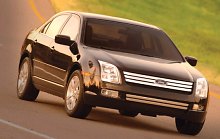 Ford
names the American Fusion the same as the European Fusion, but this
Fusion is not that Fusion. Any confusion? the European Fusion is a
version of Fiesta, two class below the Mondeo-sized American Fusion.
The latter, together with the larger Ford Five Hundred, replaces the
old and tired Taurus thus it competes head on with Toyota Camry and
Honda Accord in North America. Ford
names the American Fusion the same as the European Fusion, but this
Fusion is not that Fusion. Any confusion? the European Fusion is a
version of Fiesta, two class below the Mondeo-sized American Fusion.
The latter, together with the larger Ford Five Hundred, replaces the
old and tired Taurus thus it competes head on with Toyota Camry and
Honda Accord in North America.
After the disappointing Five Hundred, most car journalists were afraid
that Fusion would be another disappointment. A closer look at its spec
proves such view is pointless: while the Five Hundred is derived from
the dated and unremarkable Volvo S80 platform, the Fusion shares
platform with the fun driving Mazda 6. While the Five Hundred's 3-litre
V6 lacks power to cope with its heavy weight, the same engine should
work much better in the 200 kg lighter Fusion.
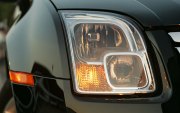 While
the Five Hundred looks dull and conservative, the Fusion looks smart
and characterful. Its design was inspired by Ford 427, a styling
concept in 2003 Detroit motor show. It was originally a big car design,
but Ford successfully downsized it to fit the medium size Fusion. Its
square profile is unique in the class, but the most beautiful part is
the nose with chromed 3-bar grille (which looks classy) and a pair of
smooth integrating headlamps (which looks cyber). As a result, the
distinctive front end makes the car instantly recognizable from
distant. While
the Five Hundred looks dull and conservative, the Fusion looks smart
and characterful. Its design was inspired by Ford 427, a styling
concept in 2003 Detroit motor show. It was originally a big car design,
but Ford successfully downsized it to fit the medium size Fusion. Its
square profile is unique in the class, but the most beautiful part is
the nose with chromed 3-bar grille (which looks classy) and a pair of
smooth integrating headlamps (which looks cyber). As a result, the
distinctive front end makes the car instantly recognizable from
distant.
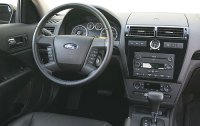 Mazda
6's cabin is quite cramped by class standard, so Ford stretched its
wheelbase by 5 cm and extended its width by 5.5 cm. The roof is also
raised by nearly 2 cm. This makes the Fusion on a par with Accord and
Camry in all dimensions. Inside, cabin space matches its rivals too.
What really surprising is the leap it took in quality. Although the
Fusion is built in the Mexico plant, its fit and finish is close to the
Japanese cars. It employs plenty of soft-touch plastics throughout the
cabin. The piano black console panel looks cool. The knobs and switches
works smoothly. Remarkable ergonomics is implemented by nice
positioning of switches, initiative audio and climate control,
excellent
driving position and fully adjustable steering wheel. In the top V6
model, it includes comfy and expensive looking stitched leather seats.
Everything in the cabin feels up to the Japanese standard. However, the
Japanese cars set the standard a few years ago. We know they will
naturally raise the standard again soon. That said, Ford Fusion is at
least in a favourable position against the newcomer Hyundai Sonata. Mazda
6's cabin is quite cramped by class standard, so Ford stretched its
wheelbase by 5 cm and extended its width by 5.5 cm. The roof is also
raised by nearly 2 cm. This makes the Fusion on a par with Accord and
Camry in all dimensions. Inside, cabin space matches its rivals too.
What really surprising is the leap it took in quality. Although the
Fusion is built in the Mexico plant, its fit and finish is close to the
Japanese cars. It employs plenty of soft-touch plastics throughout the
cabin. The piano black console panel looks cool. The knobs and switches
works smoothly. Remarkable ergonomics is implemented by nice
positioning of switches, initiative audio and climate control,
excellent
driving position and fully adjustable steering wheel. In the top V6
model, it includes comfy and expensive looking stitched leather seats.
Everything in the cabin feels up to the Japanese standard. However, the
Japanese cars set the standard a few years ago. We know they will
naturally raise the standard again soon. That said, Ford Fusion is at
least in a favourable position against the newcomer Hyundai Sonata.
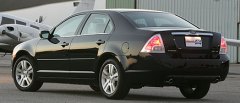 On the
road, the cabin is very well insulated from wind and road noise. Ford
must have paid a lot of attention to the door and window sealing and
sound deadening materials. In fact, they also reinforced the Mazda 6
chassis by 13 percent (torsional stiffness) to improve NVH suppression.
As in its cousin, the front double wishbones and multi-link rear
suspensions are mounted on rubber-isolated sub-frames to reduce NVH. On the
road, the cabin is very well insulated from wind and road noise. Ford
must have paid a lot of attention to the door and window sealing and
sound deadening materials. In fact, they also reinforced the Mazda 6
chassis by 13 percent (torsional stiffness) to improve NVH suppression.
As in its cousin, the front double wishbones and multi-link rear
suspensions are mounted on rubber-isolated sub-frames to reduce NVH.
Like Mazda 6, the Fusion rides firm yet supple and quiet. Its tight
body control and agile handling place it above Honda Accord in driver
appeal. Its steering also worth noting: nicely weighted, linear and
accurate. It makes a good balance between feel and refinement,
filtering the unwanted kickbacks but leaves the road feel you want.
Overall, the Fusion handles as well as its platform donor but rides
slightly better.
What Fusion can't match its Japanese rivals is the powerplant. The
Duratec aluminum 3.0 V6 with intake variable valve timing can trace
back its roots from Taurus, so it does not rev as smooth and as quiet
as its rivals. With 221 horsepower, it also trails its rivals by 15-20
horsepower. Mated with an Aisin-built 6-speed automatic gearbox, the
Fusion takes about 8.0 sec to accelerate to 60 mph, or half a second
behind
its rivals. The 6-speed gearbox is the first of its class. It offers
smooth gearshift and perfectly matched ratios. Unfortunately, not only
lacks manual mode, it even discarded the usual 1st, 2nd etc. to cut
cost, leaving only D and L to choose from.
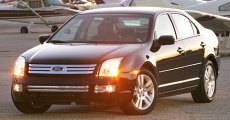 That's
why I suspect the base engine could be a more attractive purchase. It
employs Mazda's 2.3-litre 16V straight-4 with intake VVT and balance
shafts, good for 160 horsepower and 156 lbft of torque. It mates with a
regular 5-speed manual or 5-speed auto. Price start from US$18,000 (V6
starts from $21,000), undercutting its Japanese rivals but not Hyundai
Sonata of course. The Mazda engine should be refined enough to fight
against its rivals. That's
why I suspect the base engine could be a more attractive purchase. It
employs Mazda's 2.3-litre 16V straight-4 with intake VVT and balance
shafts, good for 160 horsepower and 156 lbft of torque. It mates with a
regular 5-speed manual or 5-speed auto. Price start from US$18,000 (V6
starts from $21,000), undercutting its Japanese rivals but not Hyundai
Sonata of course. The Mazda engine should be refined enough to fight
against its rivals.
No matter 2.3 or 3.0, Ford Fusion is already a highly competitive
mid-size sedan. Its unique and tasteful design, good comfort, fine
quality and sounded refinement enables it to attract the majority
buyers while the class-leading handling (together with Mazda 6) could
make it a favourite to keen drivers, something Focus did. However, the
game is moving on quickly. The Japanese will undoubtedly lift the game
when they replace Camry and Accord in the coming 1-2 years. At the
lower end, Hyundai is also eating into the market with its bargain
Sonata. Good though it is, Ford Fusion might not be good enough to fend
off the challenge in the future. |
| The
above report was last updated on 3 Oct 2005. All
Rights Reserved. |
Mercury
Milan
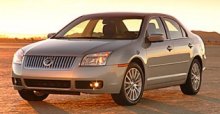
Again, the Mercury version is the same car as Ford Fusion but with a
different grille and rear end restyle. The cabin gets slightly
different trimming and more standard equipment.
Lincoln Zephyr (Now renamed to MKZ)
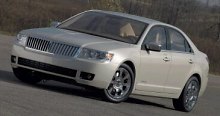 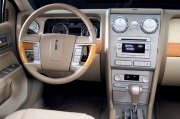
It looks more upmarket than its Ford sister in order to ask for a
higher price. While the basic profile is the same, its waterfall grille
is more elegant while a different dashboard design reminds you of
traditional Lincoln. Underneath is the same mechanicals, although it
will get a more powerful 3.5 V6 alongside the 3.0 V6 while the inline-4
engine is discarded. 4-wheel-drive will be available. |
| The
above report was last updated on 3 Oct 2005. All
Rights Reserved. |
Fusion facelift 2009 and Fusion Hybrid
|
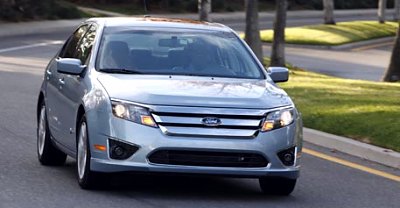
|
Viewing from the front, the facelifted
Fusion looks really refreshing... you might mistake it with a new car
from European Ford...
|
More
than 3 years have passed since Ford Fusion went on sale. As predicted
in my original report, it aged quickly. A mid-life refresh is
desperately needed. Fortunately, Ford still has money to do that
despite of credit crunch. Modifications to the 2010 Fusion concentrate
on 3 areas: 1) Facelift, 2) More powerful engines and 3) Lower fuel
consumption. They address the weaknesses of the current car.
Viewing from the front, the facelifted Fusion looks really refreshing.
If not the rest of the car retains that boxy profile, you might think
it is an all-new car from European Ford. Peter Horbury's design team
finally mastered the technique to design beautiful cars for North
America. They injected what they learned from Ford Europe, such as a
3-dimensional nose and sporty bumper intakes, and merged with the
American-originated 3-bar grille. The latter is now even more prominent
and tasteful than ever. This, in addition to the thinner new headlamps
and pronounced bonnet, completed a successful facelift. Inside, the
cabin also gets some upgraded materials and equipments, but overall
speaking the interior of Fusion is still an unattractive place -
boring, inexpensive and a bit small by class standard.
In a bid to stop people criticizing its modest performance, Ford
improved all its engines. The base Mazda 2.3-liter 4-pot engine has
been upgraded to 2.5 liters like what has happened to Mazda 6.
Horsepower increased by 15 hp to 175 hp. The long-serving uratec 3.0 V6
received new intake manifolds and a new "Cam Torque Actuated" intake
VVT to boost power from 221 to 240 hp. Nevertheless, both Fusions weigh
dozens of kilograms more than their predecessors, so performance gain
is modest. Fortunately, Ford finally introduces its 3.5-liter Duratec
V6 into the top Fusion. With 263 horsepower on tap, it has a better
chance to compete with the powerful Japanese rivals.
As for fuel consumption, the four-cylinder Fusion achieves a 10 percent
improvement, thanks partly to the upgrade from 5-speed to 6-speed
manual or automatic gearbox, partly to the switch from hydraulic to
electrical power steering. The latter is also compulsory on the 3.0 V6
model, which achieves a fuel saving of 4-6 percent. Only the 3.5 Sport
continues to employ hydraulic steering.
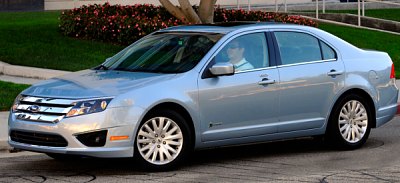
|
With the excellent hybrid, Ford proves
that economy and driver appeal are not mutually exclusive...
|
Fusion
Hybrid
However, by far the most interesting member of the 2010 Fusion is the
new Hybrid version. Its powertrain combines the base 2.5-liter
four-cylinder engine, a pair of AC electric motors and a CVT
transmission. The motors are supplied by a NiMH battery, which is
recharged by regenerative braking or the gasoline engine. To enable the
car to run purely on electric mode, Ford changed most engine-driven
systems to electric powered, such as the air-con, power steering and
brake servo. New instrument panel displays status of the hybrid power
system.
In order to optimize fuel savings, the engine is configured to run at
Atkinson cycle*, therefore power and torque are down to 156 hp and 136
lb-ft respectively. The electric motors produce another 106 horsepower
and 166 lb-ft, with the latter available right from the bottom end.
Combined output is 191 hp, enough for the 1725 kilograms car to do 0-60
mph in 8.5 seconds. It might be slower than a Toyota Camry Hybrid, but
it achieves considerably higher fuel efficiency. EPA rated it at 41 mpg
for city and 36 mpg for highway, which is far better than Camry Hybrid
(33/34 mpg), Altima Hybrid (35/33 mpg) and the mild hybrid Chevrolet
Malibu / Saturn Aura (26/34 mpg). How can it beat the Japanese in their
own game ? The answer is by using more powerful electric motors. This
enables Fusion to run up to 47 mph purely in electric mode (versus 25
mph in Camry), which means in normal driving 60 percent of the time the
gasoline engine can be switched off.
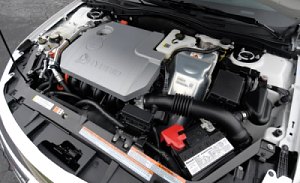
|
How can it beat the Japanese in their
own game ? The answer is more powerful electric motors...
|
As in most other hybrids, the transition between gasoline and electric
power is so seamless that you are difficult to detect. The powertrain
refinement is excellent. The electric power steering and drive-by-wire
brake pedal are also well weighted, unlike most hybrids. Moreover, like
the rest of the Fusion range, it is fun to drive in challenging roads.
The suspension is supple yet maintain good control. The chassis is
nimble. The steering is accurate and consistent. Ford proves that
economy and driver appeal are not mutually exclusive.
Any down side ? High price, boxy appearance, cheap interior and smaller
than rivals.
* Atkinson cycle: conventional engines
run at Otto cycle, in which intake valves close when the piston reaches
the lowest position. In contrast, an engine operating at Atkinson cycle
do not close its intake valves until the piston has well entered
compression stroke. As some fresh air is pumped back into intake
manifolds before the intake valves closed, the effective displacement
is reduced. For example, a 2.5-liter Atkinson engine may be actually
equivalent to a 2.3-liter Otto engine. As a result, it also produces
less power and torque. However, in expansion cycle the 2.5-liter
Atkinson engine works exactly the same as a 2.5-liter Otto engine, i.e.
with the same length of expansion stroke. This makes better use of the
thermal energy in the heated gas, thus it delivers higher fuel
efficiency. |
| The
above report was last updated on 27 Dec
2008. All Rights Reserved. |
|
|
|
General remarks
|
Fusion 2.3 (2005)
|
Fusion 3.0 (2005)
|
Lincoln MKZ 3.5 AWD (2005)
|
Layout
|
Front-engined, FWD
|
Front-engined, FWD
|
Front-engined, 4WD |
Chassis
|
Steel monocoque
|
Steel monocoque |
Steel monocoque |
Body
|
Mainly steel
|
Mainly steel |
Mainly steel |
| Length / width / height |
4830 / 1835
/ 1453 mm |
4830 / 1835
/ 1453 mm |
4840 / 1835
/ 1453 mm
|
| Wheelbase |
2728 mm |
2728 mm |
2728 mm
|
Engine
|
Inline-4
|
V6, 60-degree
|
V6, 60-degree |
Capacity
|
2261 cc
|
2967 cc |
3496 cc
|
Valve gears
|
DOHC 16 valves, VVT
|
DOHC 24 valves, VVT |
DOHC 24 valves, VVT |
Induction
|
-
|
- |
VIM
|
Other engine features
|
-
|
-
|
-
|
Max power
|
160 hp |
221 hp |
263 hp
|
Max torque
|
156 lbft |
205 lbft |
249 lbft
|
Transmission
|
5-speed automatic
|
6-speed automatic
|
6-speed automatic
|
Suspension layout
|
F: double-wishbone
R: multi-link
|
F: double-wishbone
R: multi-link |
F: double-wishbone
R: multi-link |
Suspension features
|
-
|
- |
- |
Tyres front/rear
|
205/60R16
|
225/50R17
|
225/50R17
|
Kerb weight
|
1432 kg
|
1488 kg
|
1730 kg
|
Top speed
|
-
|
-
|
127 mph (limited)
|
0-60 mph (sec)
|
9.5*
|
7.4*
|
7.3*
|
0-100 mph (sec)
|
32.9*
|
19.7*
|
19.2*
|
| Performance
tested by: |
*C&D |
|
Fusion 2.5 (2009)
|
Fusion 3.0 (2009)
|
Fusion 3.5 AWD (2009)
|
Layout
|
Front-engined, FWD
|
Front-engined, FWD
|
Front-engined, 4WD |
Chassis
|
Steel monocoque
|
Steel monocoque |
Steel monocoque |
Body
|
Mainly steel
|
Mainly steel |
Mainly steel |
| Length / width / height |
4841 / 1834
/ 1445 mm |
4841 / 1834
/ 1445 mm |
4841 / 1834
/ 1445 mm
|
| Wheelbase |
2728 mm |
2728 mm |
2728 mm
|
Engine
|
Inline-4
|
V6, 60-degree
|
V6, 60-degree |
Capacity
|
2488 cc
|
2967 cc |
3496 cc
|
Valve gears
|
DOHC 16 valves, VVT
|
DOHC 24 valves, VVT |
DOHC 24 valves, VVT |
Induction
|
-
|
- |
VIM
|
Other engine features
|
-
|
-
|
-
|
Max power
|
175 hp / 6000 rpm
|
240 hp / 6500 rpm
|
263 hp / 6250 rpm
|
Max torque
|
172 lbft / 4500 rpm
|
223 lbft / 4300 rpm
|
249 lbft / 4500 rpm
|
Transmission
|
6-speed manual
|
6-speed automatic
|
6-speed automatic
|
Suspension layout
|
F: double-wishbone
R: multi-link
|
F: double-wishbone
R: multi-link |
F: double-wishbone
R: multi-link |
Suspension features
|
-
|
- |
- |
Tyres front/rear
|
205/60R16
|
225/50R17
|
225/45R18
|
Kerb weight
|
1490 kg
|
1563 kg
|
1725 kg
|
Top speed
|
-
|
-
|
127 mph (limited)
|
0-60 mph (sec)
|
8.0*
|
7.1*
|
6.7*
|
0-100 mph (sec)
|
21.1*
|
20.0*
|
17.6*
|
| Performance
tested by: |
*C&D |
|
Fusion Hybrid
|
|
|
Layout
|
Front-engined, FWD
|
|
|
Chassis
|
Steel monocoque
|
|
|
Body
|
Mainly steel
|
|
|
| Length / width / height |
4841 / 1834
/ 1445 mm |
|
|
| Wheelbase |
2728 mm |
|
|
Engine
|
Inline-4, Atkinson cycle, AC motor
|
|
|
Capacity
|
2488 cc
|
|
|
Valve gears
|
DOHC 16 valves, VVT
|
|
|
Induction
|
-
|
|
|
Other engine features
|
-
|
|
|
Max power
|
156
hp / 6000 rpm (engine)
106 hp / 6500 rpm (motor)
191 hp (combined)
|
|
|
Max torque
|
136
lbft / 2250 rpm (engine)
166 lbft / 0-3000 rpm (motor)
|
|
|
Transmission
|
CVT
|
|
|
Suspension layout
|
F: double-wishbone
R: multi-link
|
|
|
Suspension features
|
-
|
|
|
Tyres front/rear
|
225/50VR17
|
|
|
Kerb weight
|
1725 kg
|
|
|
Top speed
|
108 mph (limited)
|
|
|
0-60 mph (sec)
|
8.5*
|
|
|
0-100 mph (sec)
|
21.5*
|
|
|
| Performance
tested by: |
*C&D |
|
|